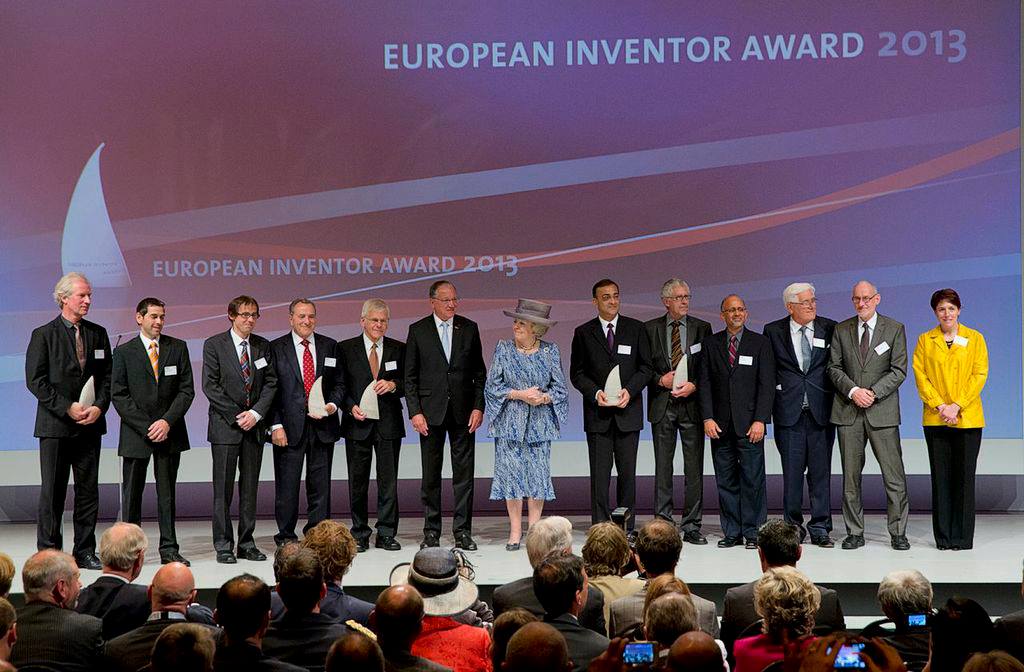The Winners of the European Inventor Award 2013

European Inventor Award 2013 goes to outstanding inventors from Austria, France, Sweden, Switzerland, Spain and the US
· European Patent Office honours pioneering inventors of LCD technology, nano-capsules for cancer treatment, pyrosequencing, USB, and ‘Blumotion’ damper system for doors
· EPO President Benoît Battistelli: “These inventors have been truly exemplary, not only in coming up with ingenious solutions to the challenges of our time, such as healthcare and climate change, but also in improving people’s lives through the quality of the products and services that we are using every day, and by creating jobs to promote economic wealth”
Amsterdam, 28 May 2013 — The European Patent Office today announced the winners of the European Inventor Award2013, which honours outstanding inventors for their contribution to social, economic and technological progress.
Some 500 guests attended the award ceremony at the Beurs van Berlage in Amsterdam, including Her Royal HighnessPrincess Beatrix of the Netherlands, Sander Dekker, the Netherlands State Secretary for Education, Culture and Science, and Michel Barnier, the European Commissioner for Internal Market and Services.
The 2013 awards were presented in five categories, in addition to the Popular Prize:
· Lifetime Achievement: Martin Schadt (Switzerland), inventor of the world’s first flat-panel liquid crystal display, better known as LCD. Schadt’s technology has paved the way for the low-energy devices, such as flat screens, tablet computers and mobile phones, now used by millions of people worldwide.
· Industry: Claus Hämmerle and Klaus Brüstle (Austria) from Austrian manufacturer Julius Blum for their invention of a damper system for soft closing of furniture doors, drawers and wall cabinets. ‘Blumotion’ has seen enormous market success worldwide and has become an industry standard.
· Small and Medium-Sized Enterprises: Pål Nyrén (Sweden) for inventing pyrosequencing ─ a far faster, less complicated and cheaper method of sequencing DNA strands. Its combination of lower costs and greater speeds has revolutionised the study of the building blocks of life, and opened up new avenues for research into personalised treatments and cures for life-threatening diseases such as cancer.
· Research: Patrick Couvreur, Barbara Stella, Véronique Rosilio, Luigi Cattel (France, Italy), a team at Paris-Sud University, for their invention of nano-capsules – 70 times smaller than red blood cells and protected by a biodegradable coating – which destroy cancer cells without harming healthy tissue.
· Non-European Countries: Ajay V. Bhatt, Bala Sudarshan Cadambi, Jeff Morriss, Shaun Knoll, Shelagh Callahan (USA), for creating and developing Universal Serial Bus (USB) technology, one of the most important advances in computing since the silicon chip. An industry standard today, USB not only allows users to more easily connect devices to a computer, it also streamlines work for hardware and software developers. It is found in billions of electronic devices all over the world, from webcams to cell phones and memory sticks.

· The winner of the Popular Prize was José Luis López Gómez (Spain), whose invention to use a unique ‘independent guided’ wheel design rather than a standard axle on high-speed passenger trains makes those trains some of the most comfortable and safe in the industry. The new technology also helps to reduce energy consumption, premature wear and costs of maintenance. An electronic system monitors the speed at which the wheels are rotating. Due to the wheels’ slightly conical shape and the difference in length between the inner and outer tracks on a curved section of track, the system can determine the wheels’ exact contact point. Pneumatic struts attached to the wheels then move the wheels to the best position.
“Innovation holds the key to safeguarding quality of life and economic prosperity in Europe,” said EPO President Benoît Battistelli at the award ceremony. “All of the inventors honoured here today have been truly exemplary, not only in coming up with ingenious solutions to challenges of our time, such as healthcare and climate change, but also in improving people’s lives through the quality of the products and services that we are using every day, and by creating jobs to promote economic wealth. They demonstrate Europe’s creative drive and inventive spirit, and the role played by patents in supporting this.”
About the European Inventor Award
Launched in 2006, the European Inventor Award is presented annually by the European Patent Office. The Award honours inventive individuals and teams whose pioneering work provides answers to the challenges of our age and thereby contributes to social progress, economic growth and prosperity. Nomination proposals are submitted by the public, and by patent examiners at the EPO and Europe’s national patent offices. Fifteen finalists and, subsequently, the winners are chosen from among the nominees by a high-profile international jury which includes experts from business, politics, media, academia and research. The Award is presented in five categories: Industry, Research, Small and Medium-Sized Enterprises (SMEs), Non-European Countries, and Lifetime Achievement. This year, for the first time, the general public was invited to vote for the Popular Prize from among the 15 finalists.
 Follow
Follow